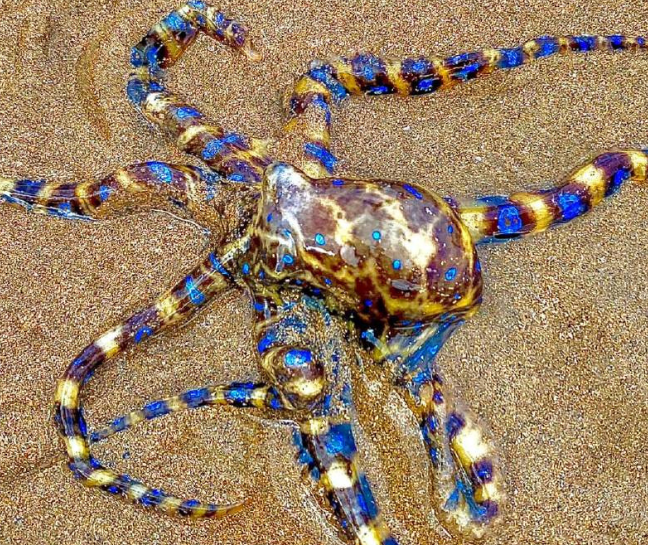Exploring the Enigmatic World of Blue-Ringed Octopuses.
Recently a local resident came across a Blue-ringed octopus on the edge of Murchison River foreshore. Known as the only octopus that’s poisonous to humanity I thought an informative article was called for since these guys are venomous, attractiveness to children and found at Blue Holes and surrounds.
Blue-ringed octopuses are found in the warm coastal waters of the Pacific and Indian ocean’s along the coast of Australia, from Western Australia to Queensland. They can be found in various habitats within these regions, including tidal pools, sandy or rocky bottoms, coral reefs, empty shell’s and seagrass beds.
Blue-ringed octopuses are typically found in shallow waters, often in depths of less than 20 meters, although they can occasionally be found at greater depths. These marine animals have a short life span of around two years. During the reproductive process, both the male and female die. The male dies soon after mating. The female lays her eggs incubating them under her tentacles for six months. During incubation the female won’t feed and once eggs hatch she dies from starvation. All octopi lifespan is limited by reproduction.
I have picked up dead shells whilst diving off Rottnest Island, Perth waters and the Abrolhos Islands containing a Blue-ring octopus. One was the size of a ten cent piece and luckily not bitten. These octopi are known for their vibrant blue rings and highly venomous nature. It is important to exercise caution and avoid contact with these octopuses in their natural habitat to avoid potential bites and venomous envenomation.
Fifty year’s back I witnessed a person playing with a blue ring octopus in his hand. He was able to mumble “octopus!” before lapsing into unresponsiveness. Although he was unable to speak he was aware of us giving him cardiopulmonary resuscitation saving his life. A bite can usually be painless, but the victim will feel numb around the mouth, tongue, face, neck and feel tight in the chest with breathing issues.
Blue-ringed octopuses generally range in size from just a few centimeters to around 20 centimeters, depending on the three species. They are small and often mistaken for harmless creatures due to their size and innocent appearance.
Being bitten by a Blue-ringed octopus can have severe consequences due to their highly venomous nature. The venom of the Blue-ringed octopus contains a toxin called tetrodotoxin, which affects the central nervous system.
There isn’t antivenom available.
In Australia there have been three recorded deaths in the past century.
The specific side effects can vary, but may include the following:
1. Localized pain and swelling: The bite can cause pain and swelling at the site of the bite, similar to any other venomous bite.
2. Muscle weakness: Tetrodotoxin affects the muscles, leading to weakness and difficulty moving.
3. Respiratory distress: The venom can affect the respiratory system, leading to difficulty breathing or even respiratory failure.
4. Paralysis: The venom causes paralysis, which can progress rapidly, affecting the entire body.
5. Loss of consciousness: Severe envenomation can lead to loss of consciousness or unconsciousness.
It is important to note that the effects of the venom can occur rapidly, sometimes within minutes. Therefore, if you suspect that you have been bitten by a Blue-ringed octopus or if venom has been injected, immediate medical attention is crucial.
Seeking prompt medical assistance is vital to ensure the application of appropriate treatment, immediately commence CPR.
There isn’t Antivenom!
The bacteria that produces the toxin live in a symbiotic relationship with the octopus. There is no antivenom for tetrodotoxin, which is also used by other living organism’s including Puffer fish and Papua New Guinea’s Pitohui bird where it stores toxins in its feathers and skin.
Remember, interactions with Blue-ringed octopuses should always be avoided to prevent potential bites and envenomation. The blue colour only becomes easily visible when they are threatened, most of the time they look like regular brown octopuses.
Even though small they’re lethal enough to kill 26 adults all within minutes.

